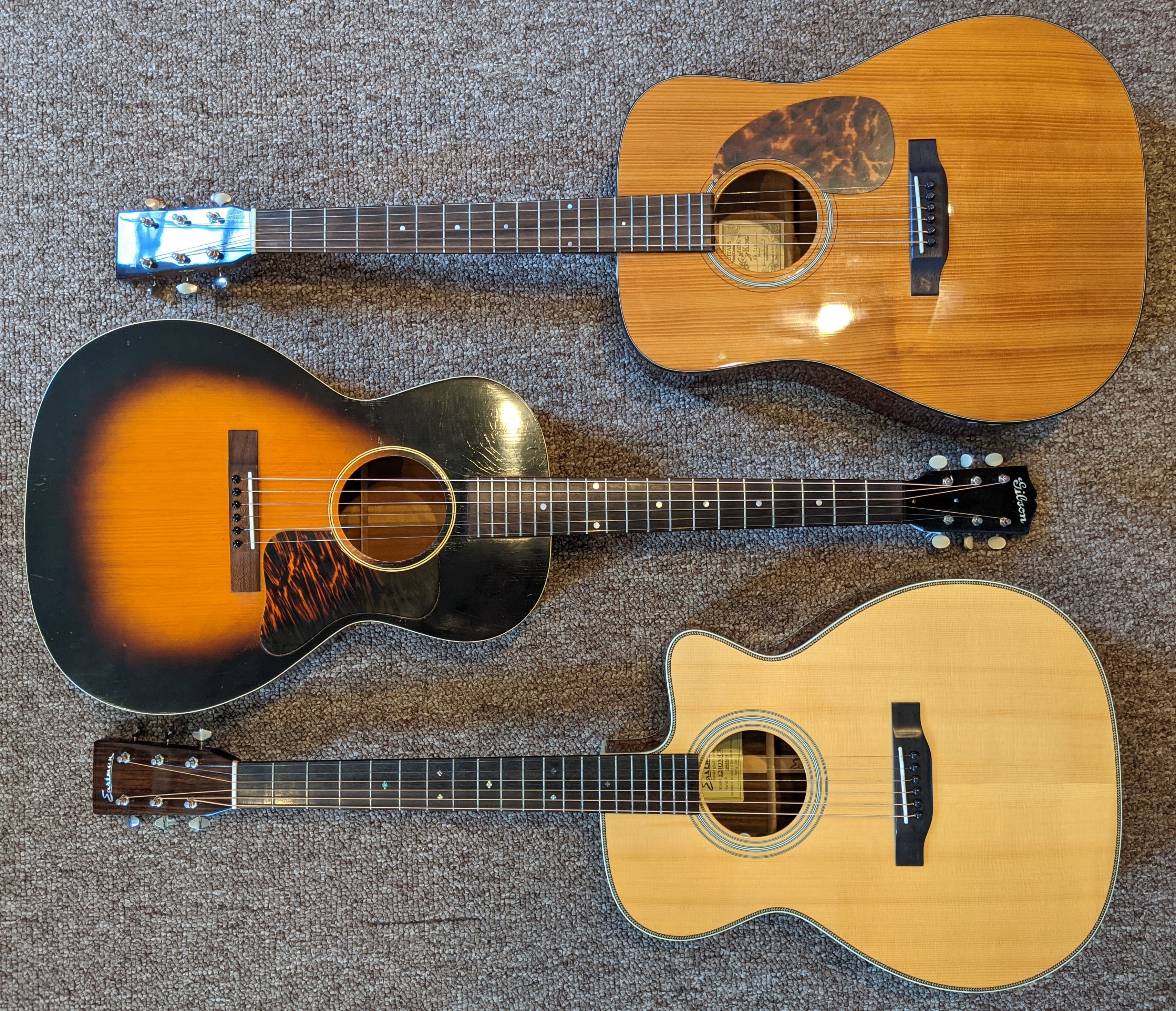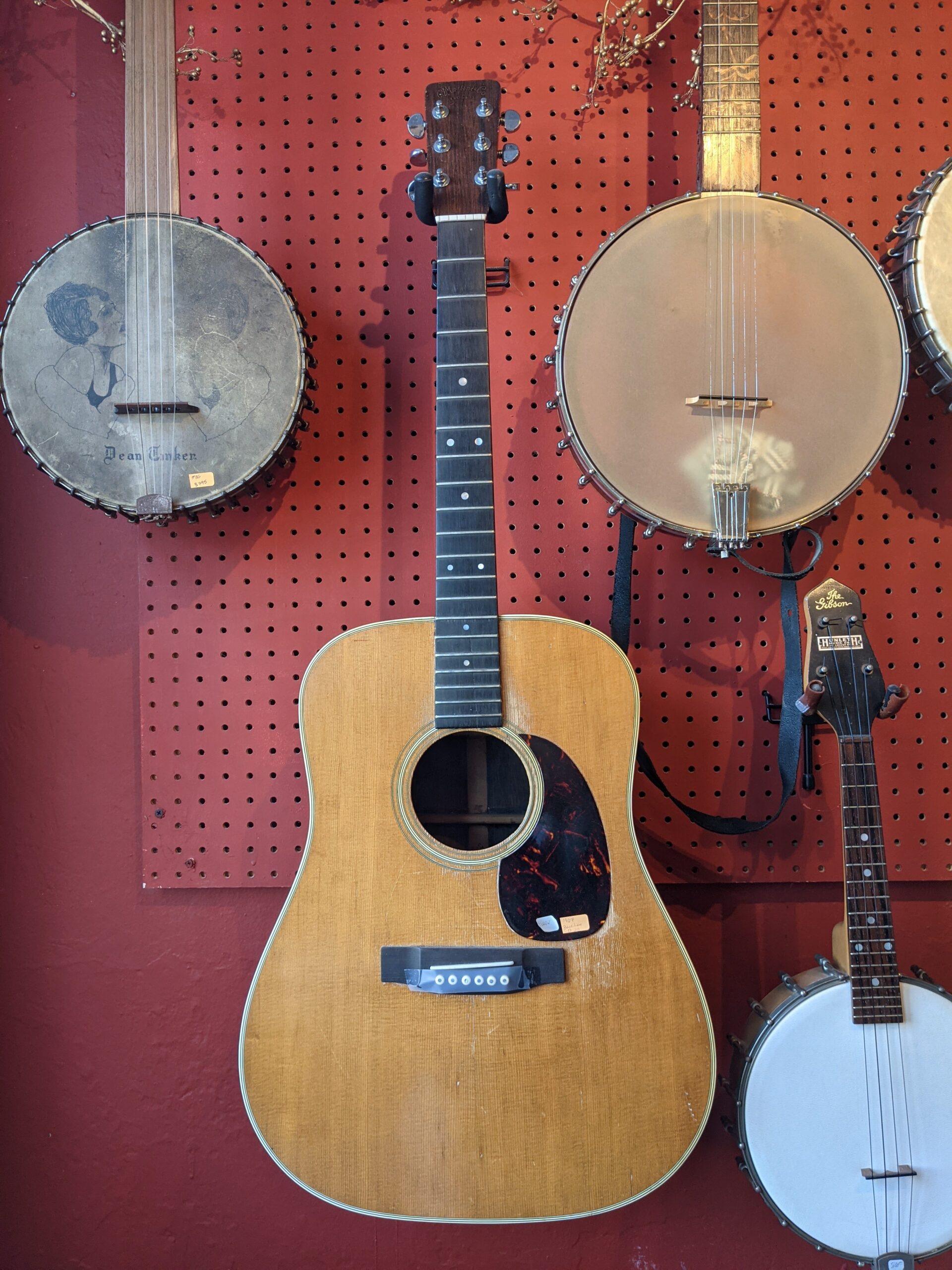
Guitars at Vintage Music
The guitar, one of Pick & Bow’s most popular instruments, is related to instruments of the lute family such as the Roman cithara and the Arabic oud. Characteristics such as its hourglass shape and six-strings were present by the early seventeenth century. In the late eighteenth century, European immigrants brought some of the first guitars into the U.S. Although many early guitars had gut strings, which have a soft sound, guitars in the U.S. were the first to have steel strings, which have more volume and clarity. Steel strings were tighter too, which affected the playing styles of guitarists. Instead of fingerpicking delicate melodies, playing chords and using picks became more common among musicians. Christian Frederick Martin, a German-born American guitar maker who founded the guitar company Martin Guitars & Co., pioneered a guitar design interior X-bracing that was strong enough to handle the tension of steel strings, which is now the most common form of acoustic guitar in the world. As purchasing options expanded through manufacturers like Martin and Gibson, and stores like Sears-Roebuck made instruments orderable by mail, guitars became more common in urban and rural areas alike.
Performance by oud musician, Rahim AlHaj (NPR Tiny Desk)

1967 Brazilian Rosewood Martin D-28 guitar (in repair) at Vintage Music
Over the last century and a half, a variety of guitar playing styles have been used in Appalachian music. More portable and less expensive than pianos or organs, guitars were a perfect accompaniment instrument that easily provided bass, chords, or melody in many genres of music. One distinctive style of music that guitar has been foundational to is the blues, defined by a melancholy, lonesome sound that African Americans developed along from coastlines and brought further inland, from the Appalachian Mountains to the Mississippi River Delta. Guitars were also used by the African American string bands who played for square dances even just a decade following emancipation.
Atlanta-based blues musician ‘Barbeque’ Bob Hicks playing “Yo Yo Blues” (1929)
By the late 1920s, guitars commonly accompanied fiddlers and singers on records and in radio broadcasts of music of the region. Many ensembles lacked bass, so guitar players often incorporated melodic bass note runs, mimicking the bass sound that a tuba, trombone, or piano would provide in an orchestra. A great example of a musician who uses this technique is Riley Puckett, a blind guitar player from north Georgia who was part of a popular string band that was one of the first to be commercially recorded, the Skillet-Lickers. Another popular style of playing guitar is the “Carter Scratch,” pioneered by Maybelle Carter of the Carter Family, who used a thumb and finger pick to play bass lines, melody, and rhythm. Her technique was influenced by African American blues guitarist Leslie Riddle (recorded by A.P. Carter, her brother in law), and her experiences playing autoharp and banjo. Other uses of guitar include backing up ballad singing or playing lead melody on fiddle tunes, as commonly heard in bluegrass guitar. Listen below for some of the variety of playing styles in guitar.
Riley Puckett playing rhythm-lead guitar on “Story of the Bear and the Preacher” (1939)
Mother Maybelle Carter playing the Carter Scratch style on the song, “Wildwood Flower”
Molly Tuttle playing cross-picking guitar on “White Freightliner Blues”
JOKE
Q: What is the difference between a rock guitarist and a jazz guitarist?
.
.
.
.
.
.
.
.
.
.
.
.
A: One plays three chords in front of thousands of people, the other plays thousands of chords in front of three people.
Listening
REFERENCES
“American Roots Music : Instruments and Innovations – The Guitar.” PBS. Public Broadcasting Service, 2001. https://www.pbs.org/americanrootsmusic/pbs_arm_ii_guitar.html.
Carr, Joe. “The Pioneers of Flatpicking.” Flatpicking Guitar Magazine, 2013. https://www.flatpick.com/category_s/2215.htm.
“Guitar.” Encyclopædia Britannica. Encyclopædia Britannica, inc. Accessed February 1, 2021. https://www.britannica.com/art/guitar.
“Guitar History: How the Guitar Has Evolved.” Musicians Institute Hollywood, January 12, 2021. https://www.mi.edu/education/guitar-history-how-the-guitar-has-evolved/.
“How To Play The ‘Carter Scratch’ (Featuring Courtney Marie Andrews).” NPR. NPR, August 15, 2019. https://www.npr.org/2019/08/15/750859589/how-to-play-the-carter-scratch-featuring-courtney-marie-andrews.
Seeger, Mike. Liner notes for Early Southern Guitar Sounds, SFW CD 40157, 2007, online. https://folkways-media.si.edu/liner_notes/smithsonian_folkways/SFW40157.pdf
Ledbetter, April. “The World Of Maybelle Carter: A Turning The Tables Playlist.” NPR. NPR, August 12, 2019. https://www.npr.org/2019/08/12/748410375/the-world-of-maybelle-carter-a-turning-the-tables-playlist.
